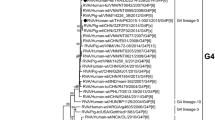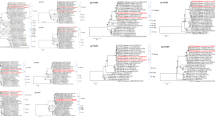Abstract
Deduced amino acid sequence and phylogenetic analyses of a group A rotavirus G9P[6] strain (designated as mcs/13-07), detected from a 3-year-old child in Eastern India, revealed a VP8* closely related to porcine P[6] strains (P[6] sublineage 1D), and the VP7 clustered with G9 lineage-III strains. To our knowledge, this is the first report of human P[6] strain clustering in sublineage Id. Thus, to further characterize the evolutionary diversity of strain mcs/13-07, all gene segments were analyzed. VP6 and NSP4 exhibited genetic relatedness to Wa-like human subgroup II strains, while VP1-3, NSP1-3 and NSP5 were closely related to porcine strains. Based on the new classification system of rotaviruses, mcs/13-07 revealed a G9–P[6]–I1–R1–C1–M1–A8–N1–T1–E1–H1 genotype with close similarity to human Wa-like and porcine Gottfried strains. Therefore, considering the porcine-like or porcine origin of multiple gene segments, it might be tempting to assume that strain mcs/13-07 represents a rare instance of whole-virus transmission from pig to human, after which the virus evolved with time. Alternatively, it is possible that strain mcs/13-07 resulted from multiple reassortment events involving human subgroup II and porcine P[6] strains. Nevertheless, detection of strain mcs/13-07 provides further evidence for complex interspecies transmission events, which are frequent in developing countries.











Similar content being viewed by others
References
Ahmed K, Anh DD, Nakagomi O (2007) Rotavirus G5P[6] in child with diarrhea, Vietnam. Emerg Infect Dis 13:1232–1235
Altschul SF, Madden TL, Schäffer AA, Zhang J, Zhang Z, Miller W, Lipman DJ (1997) Gapped BLAST and PSI-BLAST: a new generation of protein database search programs. Nucleic Acids Res 25:3389–3402
Bányai K, Martella V, Jakab F, Melegh B, Szücs G (2004) Sequencing and phylogenetic analysis of human genotype P[6] rotavirus strains detected in Hungary provides evidence for genetic heterogeneity within the P[6] VP4 gene. J Clin Microbiol 42:4338–4343
Bohl EH, Theil KW, Saif LJ (1984) Isolation and serotyping of porcine rotaviruses and antigenic comparison with other rotaviruses. J Clin Microbiol 19:105–111
Das S, Sen A, Uma G, Varghese V, Chaudhuri S, Bhattacharya SK, Krishnan T, Dutta P, Dutta D, Bhattacharya MK, Mitra U, Kobayashi N, Naik TN (2002) Genomic diversity of group A rotavirus strains infecting humans in eastern India. J Clin Microbiol 40:146–149
Dennehy PH (2007) Rotavirus vaccines—an update. Vaccine 25:3137–3141
Duan ZJ, Li DD, Zhang Q, Liu N, Huang CP, Jiang X, Jiang B, Glass R, Steele D, Tang JY, Wang ZS, Fang ZY (2007) Novel human rotavirus of genotype G5P[6] identified in a stool specimen from a Chinese girl with diarrhea. J Clin Microbiol 45:1614–1617
Estes MK, Kapikian AZ (2007) Rotaviruses. In: Knipe DM, Howley PM, Griffin DE, Lamb RA, Martin MA, Roizman B, Straus EE (eds) Fields virology, vol 2, 5th edn. Lippincott, Williams and Wilkins, Philadelphia, pp 1917–1974
Flores J, Midthun K, Hoshino Y, Green K, Gorziglia M, Kapikian AZ, Chanock RM (1986) Conservation of the fourth gene among rotaviruses recovered from asymptomatic newborn infants and its possible role in attenuation. J Virol 60:972–979
Gentsch JR, Woods PA, Ramachandran M, Das BK, Leite JP, Alfieri A, Kumar R, Bhan MK, Glass RI (1996) Review of G and P typing results from a global collection of rotavirus strains: implications for vaccine development. J Infect Dis 174(suppl 1):S30–S36
Ghosh S, Varghese V, Samajdar S, Bhattacharya SK, Kobayashi N, Naik TN (2006) Molecular characterization of a porcine Group A rotavirus strain with G12 genotype specificity. Arch Virol 151:1329–1344
Ghosh S, Varghese V, Samajdar S, Sinha M, Naik TN, Kobayashi N (2007) Evidence for bovine origin of VP4 and VP7 genes of human group A rotavirus G6P[14] and G10P[14] strains. J Clin Microbiol 45:2751–2753
Glass RI (2006) New hope for defeating rotavirus. Sci Am 294(46–51):54–55
Gouvea V, Santos N, Timenetsky Mdo C (1994) Identification of bovine and porcine rotavirus G types by PCR. J Clin Microbiol 32:1338–1340
Griffin DD, Nakagomi T, Hoshino Y, Nakagomi O, Kirkwood CD, Parashar UD, Glass RI, Gentsch JR (2002) National Rotavirus Surveillance System. Characterization of nontypeable rotavirus strains from the United States: identification of a new rotavirus reassortant (P2A[6], G12) and rare P3[9] strains related to bovine rotaviruses. Virology 294:256–269
Herring AJ, Inglis NF, Ojeh CK, Snodgrass DR, Menzies JD (1982) Rapid diagnosis of rotavirus infection by direct detection of viral nucleic acid in silver-stained polyacrylamide gels. J Clin Microbiol 16(3):473–477
Jagannath MR, Vethanayagam RR, Reddy BS, Raman S, Rao CD (2000) Characterization of human symptomatic rotavirus isolates MP409 and MP480 having ‘long’ RNA electropherotype and subgroup I specificity, highly related to the P6[1], G8 type bovine rotavirus A5, from Mysore, India. Arch Virol 145:1339–1357
Kobayashi M, Ishino M, Yang Y-H, Chawla Sarkar M, Krishnan T, Naik TN (2007) Diversity of G-type–P-type of human and animal rotaviruses and its genetic background. In: Méndez-Vilas A (ed) Communicating current research and educational topics and trends in applied microbiology. Formatex, Spain, pp 847–858
Li DD, Duan ZJ, Zhang Q, Liu N, Xie ZP, Jiang B, Steele D, Jiang X, Wang ZS, Fang ZY (2008) Molecular characterization of unusual human G5P[6] rotaviruses identified in China. J Clin Virol 42:141–148
Martella V, Bányai K, Ciarlet M, Iturriza-Gómara M, Lorusso E, De Grazia S, Arista S, Decaro N, Elia G, Cavalli A, Corrente M, Lavazza A, Baselga R, Buonavoglia C (2006) Relationships among porcine and human P[6] rotaviruses: evidence that the different human P[6] lineages have originated from multiple interspecies transmission events. Virology 344:509–519
Matthijnssens J, Ciarlet M, Heiman E, Arijs I, Delbeke T, McDonald SM, Palombo EA, Iturriza-Gómara M, Maes P, Patton JT, Rahman M, Van Ranst M (2008) Full genome-based classification of rotaviruses reveals a common origin between human Wa-Like and porcine rotavirus strains and human DS-1-like and bovine rotavirus strains. J Virol 82:3204–3219
Matthijnssens J, Ciarlet M, Rahman M, Attoui H, Bányai K, Estes MK, Gentsch JR, Iturriza-Gómara M, Kirkwood CD, Martella V, Mertens PP, Nakagomi O, Patton JT, Ruggeri FM, Saif LJ, Santos N, Steyer A, Taniguchi K, Desselberger U, Van Ranst M (2008) Recommendations for the classification of group A rotaviruses using all 11 genomic RNA segments. Arch Virol 153:1621–1629
Nakagomi T, Horie Y, Koshimura Y, Greenberg HB, Nakagomi O (1999) Isolation of a human rotavirus strain with a super-short RNA pattern and a new P2 subtype. J Clin Microbiol 37:1213–1216
Nguyen TA, Khamrin P, Trinh QD, Phan TG, Pham le D, Hoang le P, Hoang KT, Yagyu F, Okitsu S, Ushijima H (2007) Sequence analysis of Vietnamese P[6] rotavirus strains suggests evidence of interspecies transmission. J Med Virol 79:1959–1965
Nielsen NM, Eugen-Olsen J, Aaby P, Mølbak K, Rodrigues A, Fischer TK (2005) Characterisation of rotavirus strains among hospitalised and non-hospitalised children in Guinea-Bissau, 2002. A high frequency of mixed infections with serotype G8. J Clin Virol 34:13–21
Okada J, Urasawa T, Kobayashi N, Taniguchi K, Hasegawa A, Mise K, Urasawa S (2000) New P serotype of group A human rotavirus closely related to that of a porcine rotavirus. J Med Virol 60:63–69
Phan TG, Okitsu S, Maneekarn N, Ushijima H (2007) Genetic heterogeneity, evolution and recombination in emerging G9 rotaviruses. Infect Genet Evol 7:656–663
Rahman M, De Leener K, Goegebuer T, Wollants E, Van der Donck I, Van Hoovels L, Van Ranst M (2003) Genetic characterization of a novel, naturally occurring recombinant human G6P[6] rotavirus. J Clin Microbiol 41:2088–2095
Saitou N, Nei M (1987) The neighbor-joining method: a new method for reconstructing phylogenetic trees. Mol Biol Evol 4:406–425
Samajdar S, Varghese V, Barman P, Ghosh S, Mitra U, Dutta P, Bhattacharya SK, Narasimham MV, Panda P, Krishnan T, Kobayashi N, Naik TN (2006) Changing pattern of human group A rotaviruses: emergence of G12 as an important pathogen among children in eastern India. J Clin Virol 36:183–188
Samajdar S, Ghosh S, Chawla-Sarkar M, Mitra U, Dutta P, Kobayashi N, Naik TN (2008) Increase in prevalence of human group A rotavirus G9 strains as an important VP7 genotype among children in eastern India. J Clin Virol 43(3):334–339
Samajdar S, Ghosh S, Dutta D, Chawla-Sarkar M, Kobayashi N, Naik TN (2008) Human group A rotavirus P[8] Hun9-like and rare OP354-like strains are circulating among diarrhoeic children in Eastern India. Arch Virol 153(10):1933–1936
Santos N, Hoshino Y (2005) Global distribution of rotavirus serotypes/genotypes and its implication for the development and implementation of an effective rotavirus vaccine. Rev Med Virol 15:29–56
Schäffer AA, Aravind L, Madden TL, Shavirin S, Spouge JL, Wolf YI, Koonin EV, Altschul SF (2001) Improving the accuracy of PSI-BLAST protein database searches with composition-based statistics and other refinements. Nucleic Acids Res 29:2994–3005
Taniguchi K, Wakasugi F, Pongsuwanna Y, Urasawa T, Ukae S, Chiba S, Urasawa S (1992) Identification of human and bovine rotavirus serotypes by polymerase chain reaction. Epidemiol Infect 109:303–312
Varghese V, Das S, Singh NB, Kojima K, Bhattacharya SK, Krishnan T, Kobayashi N, Naik TN (2004) Molecular characterization of a human rotavirus reveals porcine characteristics in most of the genes including VP6 and NSP4. Arch Virol 149:155–172
Varghese V, Ghosh S, Das S, Bhattacharya SK, Krishnan T, Karmakar P, Kobayashi N, Naik TN (2006) Characterization of VP1, VP2 and VP3 gene segments of a human rotavirus closely related to porcine strains. Virus Genes 32:241–247
Vesikari T, Ruuska T, Koivu HP, Green KY, Flores J, Kapikian AZ (1991) Evaluation of the M37 human rotavirus vaccine in 2- to 6-month-old infants. Pediatr Infect Dis J 10:912–917
World Health Organization (1987) Manual for laboratory investigations of acute enteric infections. World Health Organization, Geneva, Switzerland. CDD/83.3
Wu H, Taniguchi K, Wakasugi F, Ukae S, Chiba S, Ohseto M, Hasegawa A, Urasawa T, Urasawa S (1994) Survey on the distribution of the gene 4 alleles of human rotaviruses by polymerase chain reaction. Epidemiol Infect 112:615–622
Acknowledgments
This study was supported by financial assistance from Indian Council of Medical Research (ICMR), New Delhi, and the Program of Founding Research Centers for Emerging and Reemerging Infectious Diseases (Okayama University-NICED, India) from the Ministry of Education, Culture, Sports, Science and Technology, Japan. A. Mukherjee and D. Dutta were supported by a Research Assistantship and Junior Research Fellowship, from ICMR and University Grant Commission, Govt. of India, respectively.
Author information
Authors and Affiliations
Corresponding author
Rights and permissions
About this article
Cite this article
Mukherjee, A., Dutta, D., Ghosh, S. et al. Full genomic analysis of a human group A rotavirus G9P[6] strain from Eastern India provides evidence for porcine-to-human interspecies transmission. Arch Virol 154, 733–746 (2009). https://doi.org/10.1007/s00705-009-0363-3
Received:
Accepted:
Published:
Issue Date:
DOI: https://doi.org/10.1007/s00705-009-0363-3




